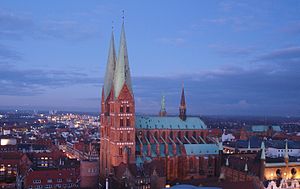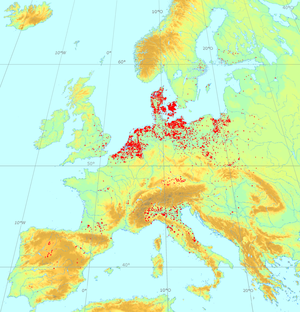
Back Baksteengotiek Afrikaans Цагляная готыка Byelorussian Цагляная готыка BE-X-OLD Cihlová gotika Czech Teglstensgotik Danish Backsteingotik German Brikogotiko Esperanto Gótico báltico Spanish Tellisgootika Estonian گوتیک آجری Persian



Brick Gothic (German: Backsteingotik, Polish: Gotyk ceglany, Dutch: Baksteengotiek) is a specific style of Gothic architecture common in Northeast and Central Europe especially in the regions in and around the Baltic Sea, which do not have resources of standing rock (though glacial boulders are sometimes available). The buildings are essentially built using bricks. Buildings classified as Brick Gothic (using a strict definition of the architectural style based on the geographic location) are found in Belgium (and the very north of France), Netherlands, Germany, Poland, Lithuania, Latvia, Estonia, Kaliningrad (former East Prussia), Denmark, Sweden and Finland.
As the use of baked red brick arrived in Northwestern and Central Europe in the 12th century, the oldest such buildings are classified as the Brick Romanesque. In the 16th century, Brick Gothic was superseded by Brick Renaissance architecture.
Brick Gothic is marked by lack of figurative architectural sculpture, widespread in other styles of Gothic architecture. Typical for the Baltic Sea region is the creative subdivision and structuring of walls, using built ornaments to contrast between red bricks, glazed bricks and white lime plaster. Nevertheless, these characteristics are neither omnipresent nor exclusive. Many historic structures and districts dominated by Brick Gothic have been listed as UNESCO World Heritage sites.
The real extent and the real variety of this brick architecture is yet to be fully distinguished from the views published in the late 19th and early 20th century, especially the years around the end of World War I, when the style was politically instrumentalized.[clarification needed]
Indeed, about a quarter of medieval Gothic brick architecture is standing in the Netherlands, in Flanders and in French Flanders. Some of these buildings are in a combination of brick and stone. The towers of St Mary's church in Lübeck, the most significant Brick Gothic church of the Baltic Sea region, have corners of granite ashlar. Many village churches in northern Germany and Poland have a Brick Gothic design despite the main constituent of their walls being boulders.
© MMXXIII Rich X Search. We shall prevail. All rights reserved. Rich X Search